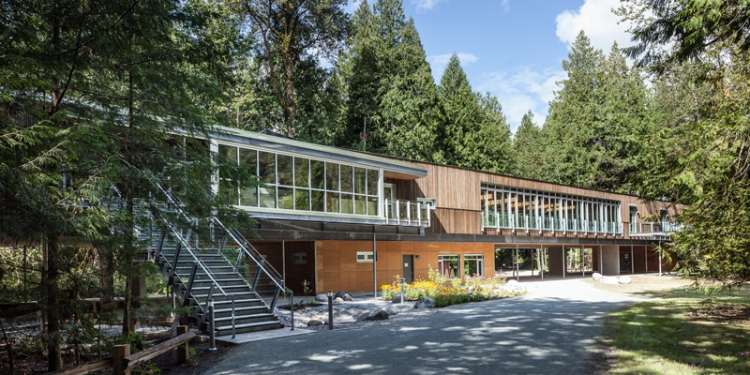We always believed that honey bees were native to British Columbia ..... "not so". But they've always been here, so they must be .... .... "NO, ...... not so".
~~~~~~~~~~~~~~~~ ~~~~~~~~~~~~~~~~
Beekeeping has been practiced in British Columbia for nearly 150 years. The first 2 hives of honey bees arrived by ship at Victoria in May, 1858. - Beekeeping in British Columbia A Brief Review
~~~~~~~~~~~~~~~~ ~~~~~~~~~~~~~~~~
In 1856, two years before Victoria got its first honeybees, Parisian Henri Harnet was given permission to set up 20 hives and teach apiculture in the Jardin du Luxembourg. The apiary and school are still active, now run by a non-profit society. - Frances Backhouse
~~~~~~~~~~~~~~~~ ~~~~~~~~~~~~~~~~
In British Columbia, where the first hives arrived by ship in 1858, honey bee pollination is now responsible for more than $160 million per year in agricultural production. In comparison, the total market value of hive products, including honey and beeswax, comes in at a paltry $8 million. - AluminUBC Trek
~~~~~~~~~~~~~~~~ ~~~~~~~~~~~~~~~~
..... has reports of bees shipped to B.C. from California in 1858 and Oregon in 1860., and a lot of stories of the first settlers who kept bees - listserv entomology
~~~~~~~~~~~~~~~~ ~~~~~~~~~~~~~~~~
John S. Harbison (1826-1912) was one of the first beekeepers to import bees into California and was an inventor of innovative beehives and new methods of rearing queen bees. He authored An Improved System of Propagating the Honey Bee (1860)
~~~~~~~~~~~~~~~~ ~~~~~~~~~~~~~~~~
John S. Harbison: There he boarded the ship, Sonora, bound for San Francisco, and upon arrival transferred to the river steamer New World, and was taken up stream to Sacramento where he arrived on December 2, 1857 with a loss of only five colonies of his original 67 with which he had started.What triggered our sudden interest in BC Beekeeping was this book from 1918, which probably helped 1921 Gardening on a City Lot three years later, in Vancouver and the Gulf Islands.
 |
| Guide to Beekeeping |
Check out this Contents Page 63 (64) on Disease... and Vancouver BC "American foul-brood" (AFB)
~~~~~~~~~~~~~~~~ ~~~~~~~~~~~~~~~~
Vancouver, Surrey, East Burnaby and Kerridale (not part of Vancouver until 1929)
Yes, check out the FactSheet Number 204
The development of antibiotic-resistant American Foulbrood (r-AFB) demands that the drug should only be applied when brood disease has been confirmed or detected nearby. It is no longer recommended for disease prevention. Dependency on antibiotics can be sharply reduced through hygienic management practices, abundance of pollen and reduction of stress (refer to Factsheet #200). Do not use antibiotic extender patties.If Antibiotics causes cattle to gain weight quickly, and because We eat meat and are gaining weight quickly, does that then mean that we shouldn't be adding honey to our .... coffee/tea or porridge...?
~~~~~~~~~~~~~~~~ ~~~~~~~~~~~~~~~~
Women Bee-keepers:
"....women have given bee-keeping as much study as the would-be typewriter gives to stenography..."
Hmmmmm perhaps the author of "Guide to Bee Keeping" should have written "typewriterist" or "type writer" or "typist" instead of being penned as a "would-be typewriter".
~~~~~~~~~~~~~~~~ ~~~~~~~~~~~~~~~~
Google Search Criteria bee honey goes with diabetes
Google Search Criteria bee honey best served
Google Search Criteria bee honey baking cooking
Google Search Criteria bee honey production
Google Search Criteria beekeeping harbison vancouver
British Columbia Beekeepers of which Valley Gold Bee Co. is one
~~~~~~~~~~~~~~~~ ~~~~~~~~~~~~~~~~
~~~~~~~~~~~~~~~~ ~~~~~~~~~~~~~~~~
Kootenay Lake 1924 Pages 9, 10 (Image), 11
Kootenay Lake 1924 Pages 9, 10 (Image), 11
Agricultue in West Kootenay~~~~~~~~~~~~~~~~ ~~~~~~~~~~~~~~~~
William J. Bonavia Secretary, BC Agricultural Department
1924
SnipThe bees are Italians, which do remarkably well, and some of the largest yields of honey per hive in the Province have been obtained in the Kootenays.Snip
The Title, if you're wondering, came from "Hugh Murray", a North Vancouver District Teacher in the 1970s where the District had introduced an Outdoor School experience near Squamish, BC. One field of endeavour was honey bees, and the fact that they were introducing a new "strain" of Honey Bees, from Italy. To make the point of the proud announcement, Hugh contacted the local columnist Jack Wasserman with a tongue in cheek comment of: "These Italian bees don't sting, they pinch!"
 |
~~~~~~~~~~~~~~~~~
 |
| First Nations Bighouse Program |
From Superintendents Blog:
by Dawn Green
The new North Shore Credit Union Environmental Learning Centre, currently under construction at the North Vancouver Outdoor School (NVOS) inParadiseValley, has won a prestigious award of merit for sustainable design.
McFarland Marceau Architects Ltd., a Vancouver-based firm that specializes in sustainable design, won the award last month during the 2011 Canadian Architect Awards of Excellence. The Canadian Architect Awards of Excellence have been running since 1968. In making their award selection, the jurors considered geographical and social context, and evaluated physical organization, materials and environmental features of the short-listed projects.
Slated to be completed by April this year, the $5.8 million Environmental Learning Centre reflects the environmental principles adopted by NVOS. The 840-square-metre building, with its raised floor and forest setting, follows a “tree house” concept and is situated above the floodplain, elevating visitors to the forest canopy. The facility, which will replace existing infrastructure at the school, features an exhibition space, dining hall, commercial kitchen, learning spaces and administrative offices. SNIPPED




/c(562-1.33333333333333-100-7.75-0)/a08naaccabc-prog12-001.jpg)
No comments:
Post a Comment